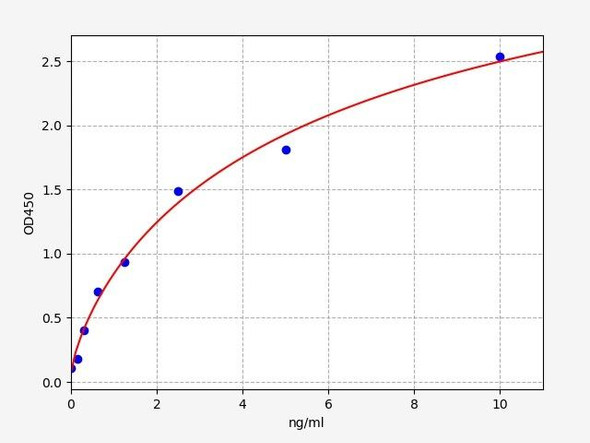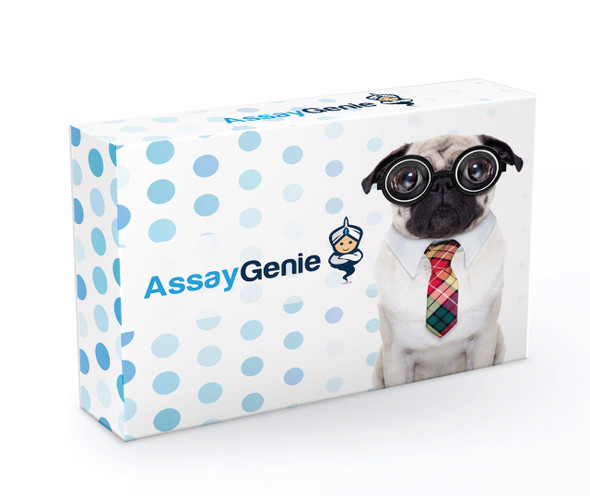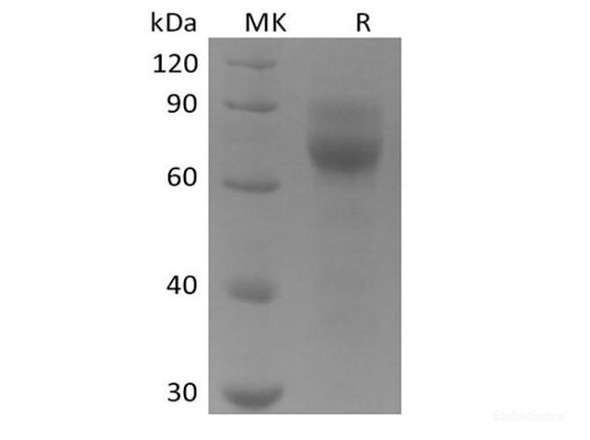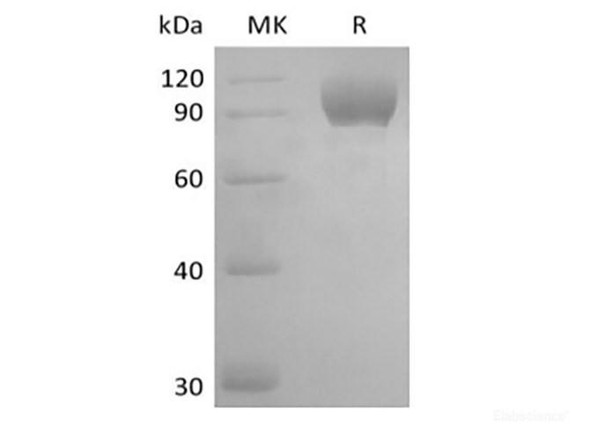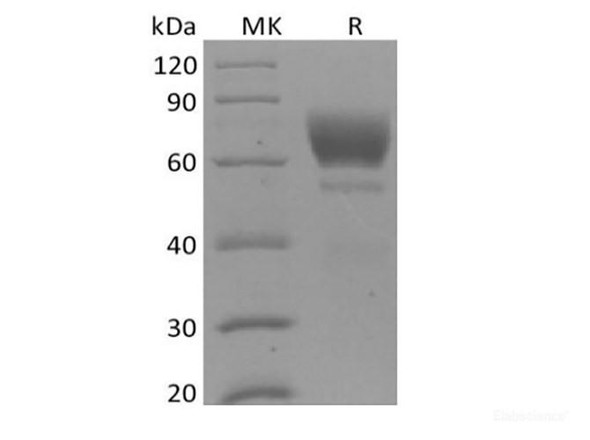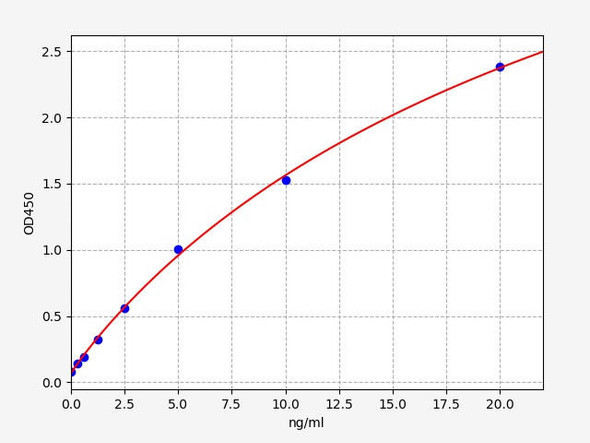Description
Human Tyrosine-protein kinase receptor UFO (AXL) ELISA Kit
The Human Tyrosine Protein Kinase Receptor UFO/AXL ELISA Kit is designed for the precise measurement of UFO/AXL levels in human serum, plasma, and cell culture supernatants. This kit offers exceptional sensitivity and specificity, ensuring accurate and consistent results for a variety of research applications.UFO/AXL is a critical protein kinase receptor involved in cell signaling pathways linked to cell growth, proliferation, and survival. Dysregulation of UFO/AXL has been implicated in various diseases, including cancer, immune disorders, and inflammatory conditions, making it a valuable biomarker for studying these diseases and developing potential therapeutic interventions.
With its reliable performance and robust design, the Human Tyrosine Protein Kinase Receptor UFO/AXL ELISA Kit is an essential tool for researchers investigating the role of UFO/AXL in health and disease.
| Product Name: | Human Tyrosine-protein kinase receptor UFO (AXL) ELISA Kit |
| SKU: | HUEB0314 |
| Size: | 96T |
| Target: | Human Tyrosine-protein kinase receptor UFO (AXL) |
| Synonyms: | AXL oncogene, UFO |
| Assay Type: | Sandwich |
| Detection Method: | ELISA |
| Reactivity: | Human |
| Detection Range: | 62.5-4000pg/mL |
| Sensitivity: | 31.31pg/mL |
| Intra CV: | 4.9% | ||||||||||||||||||||
| Inter CV: | 6.2% | ||||||||||||||||||||
| Linearity: |
| ||||||||||||||||||||
| Recovery: |
| ||||||||||||||||||||
| Function: | (Microbial infection) Acts as a receptor for lassa virus and lymphocytic choriomeningitis virus, possibly through GAS6 binding to phosphatidyl-serine at the surface of virion envelope (PubMed:22156524, PubMed:22673088, PubMed:25277499, PubMed:21501828). Acts as a receptor for ebolavirus, possibly through GAS6 binding to phosphatidyl-serine at the surface of virion envelope (PubMed:17005688). |
| Uniprot: | P30530 |
| Sample Type: | Serum, plasma, tissue homogenates, cell culture supernates and other biological fluids |
| Specificity: | Natural and recombinant human Tyrosine-protein kinase receptor UFO |
| Sub Unit: | Heterodimer and heterotetramer with ligand GAS6. Interacts with CBL, GRB2, LCK, NCK2, PIK3R1, PIK3R2, PIK3R3, PLCG1, SOCS1 and TNS2. Part of a complex including AXL, TNK2 and GRB2, in which GRB2 promotes AXL recruitment by TNK2. |
| Research Area: | Cancer |
| Subcellular Location: | Cell membrane Single-pass type I membrane protein |
| Storage: | Please see kit components below for exact storage details |
| Note: | For research use only |
| UniProt Protein Function: | AXL: a receptor tyrosine kinase that may function as a signal transducer between specific cell types of mesodermal origin. Interacts with SKP1. Overexpression in tissue culture causes oncogenic transformation. Overexpressed in several cancers including thyroid, ovarian, gastric, ER+ breast cancer and acute myeloid leukemia, where it is associated with poor prognosis. 2 isoforms of the human protein are produced by alternative splicing. |
| UniProt Protein Details: | Protein type:Oncoprotein; Protein kinase, tyrosine (receptor); Protein kinase, TK; Kinase, protein; EC 2.7.10.1; Membrane protein, integral; TK group; Axl family Chromosomal Location of Human Ortholog: 19q13.1 Cellular Component: cell surface; extracellular space; integral to plasma membrane; intracellular; plasma membrane Molecular Function:ATP binding; phosphatidylserine binding; protein binding; protein heterodimerization activity; protein-tyrosine kinase activity; transmembrane receptor protein tyrosine kinase activity; viral receptor activity Biological Process: apoptotic cell clearance; blood vessel remodeling; cell maturation; cellular response to extracellular stimulus; entry of virus into host cell; erythrocyte homeostasis; forebrain cell migration; inflammatory response; innate immune response; natural killer cell differentiation; negative regulation of interferon-gamma production; negative regulation of lymphocyte activation; negative regulation of neuron apoptosis; negative regulation of tumor necrosis factor production; neuron migration; ovulation cycle; peptidyl-tyrosine phosphorylation; phagocytosis; platelet activation; positive regulation of cytokine and chemokine mediated signaling pathway; positive regulation of natural killer cell differentiation; positive regulation of pinocytosis; positive regulation of protein kinase B signaling cascade; protein kinase B signaling cascade; secretion by cell; signal transduction; spermatogenesis; vagina development; vascular endothelial growth factor receptor signaling pathway |
| NCBI Summary: | The protein encoded by this gene is a member of the Tyro3-Axl-Mer (TAM) receptor tyrosine kinase subfamily. The encoded protein possesses an extracellular domain which is composed of two immunoglobulin-like motifs at the N-terminal, followed by two fibronectin type-III motifs. It transduces signals from the extracellular matrix into the cytoplasm by binding to the vitamin K-dependent protein growth arrest-specific 6 (Gas6). This gene may be involved in several cellular functions including growth, migration, aggregation and anti-inflammation in multiple cell types. Alternative splicing results in multiple transcript variants of this gene. [provided by RefSeq, Jul 2013] |
| UniProt Code: | P30530 |
| NCBI GenInfo Identifier: | 239938818 |
| NCBI Gene ID: | 558 |
| NCBI Accession: | P30530.3 |
| UniProt Secondary Accession: | P30530,Q8N5L2, Q9UD27, |
| UniProt Related Accession: | P30530 |
| Molecular Weight: | 97,377 Da |
| NCBI Full Name: | Tyrosine-protein kinase receptor UFO |
| NCBI Synonym Full Names: | AXL receptor tyrosine kinase |
| NCBI Official Symbol: | AXL |
| NCBI Official Synonym Symbols: | ARK; UFO; JTK11; Tyro7 |
| NCBI Protein Information: | tyrosine-protein kinase receptor UFO |
| UniProt Protein Name: | Tyrosine-protein kinase receptor UFO |
| UniProt Synonym Protein Names: | AXL oncogene |
| Protein Family: | Tyrosine-protein kinase receptor |
| UniProt Gene Name: | AXL |
| UniProt Entry Name: | UFO_HUMAN |
| Component | Quantity (96 Assays) | Storage |
| ELISA Microplate (Dismountable) | 8×12 strips | -20°C |
| Lyophilized Standard | 2 | -20°C |
| Sample Diluent | 20ml | -20°C |
| Assay Diluent A | 10mL | -20°C |
| Assay Diluent B | 10mL | -20°C |
| Detection Reagent A | 120µL | -20°C |
| Detection Reagent B | 120µL | -20°C |
| Wash Buffer | 30mL | 4°C |
| Substrate | 10mL | 4°C |
| Stop Solution | 10mL | 4°C |
| Plate Sealer | 5 | - |
Other materials and equipment required:
- Microplate reader with 450 nm wavelength filter
- Multichannel Pipette, Pipette, microcentrifuge tubes and disposable pipette tips
- Incubator
- Deionized or distilled water
- Absorbent paper
- Buffer resevoir
*Note: The below protocol is a sample protocol. Protocols are specific to each batch/lot. For the correct instructions please follow the protocol included in your kit.
Allow all reagents to reach room temperature (Please do not dissolve the reagents at 37°C directly). All the reagents should be mixed thoroughly by gently swirling before pipetting. Avoid foaming. Keep appropriate numbers of strips for 1 experiment and remove extra strips from microtiter plate. Removed strips should be resealed and stored at -20°C until the kits expiry date. Prepare all reagents, working standards and samples as directed in the previous sections. Please predict the concentration before assaying. If values for these are not within the range of the standard curve, users must determine the optimal sample dilutions for their experiments. We recommend running all samples in duplicate.
| Step | |
| 1. | Add Sample: Add 100µL of Standard, Blank, or Sample per well. The blank well is added with Sample diluent. Solutions are added to the bottom of micro ELISA plate well, avoid inside wall touching and foaming as possible. Mix it gently. Cover the plate with sealer we provided. Incubate for 120 minutes at 37°C. |
| 2. | Remove the liquid from each well, don't wash. Add 100µL of Detection Reagent A working solution to each well. Cover with the Plate sealer. Gently tap the plate to ensure thorough mixing. Incubate for 1 hour at 37°C. Note: if Detection Reagent A appears cloudy warm to room temperature until solution is uniform. |
| 3. | Aspirate each well and wash, repeating the process three times. Wash by filling each well with Wash Buffer (approximately 400µL) (a squirt bottle, multi-channel pipette,manifold dispenser or automated washer are needed). Complete removal of liquid at each step is essential. After the last wash, completely remove remaining Wash Buffer by aspirating or decanting. Invert the plate and pat it against thick clean absorbent paper. |
| 4. | Add 100µL of Detection Reagent B working solution to each well. Cover with the Plate sealer. Incubate for 60 minutes at 37°C. |
| 5. | Repeat the wash process for five times as conducted in step 3. |
| 6. | Add 90µL of Substrate Solution to each well. Cover with a new Plate sealer and incubate for 10-20 minutes at 37°C. Protect the plate from light. The reaction time can be shortened or extended according to the actual color change, but this should not exceed more than 30 minutes. When apparent gradient appears in standard wells, user should terminatethe reaction. |
| 7. | Add 50µL of Stop Solution to each well. If color change does not appear uniform, gently tap the plate to ensure thorough mixing. |
| 8. | Determine the optical density (OD value) of each well at once, using a micro-plate reader set to 450 nm. User should open the micro-plate reader in advance, preheat the instrument, and set the testing parameters. |
| 9. | After experiment, store all reagents according to the specified storage temperature respectively until their expiry. |
When carrying out an ELISA assay it is important to prepare your samples in order to achieve the best possible results. Below we have a list of procedures for the preparation of samples for different sample types.
| Sample Type | Protocol |
| Serum | If using serum separator tubes, allow samples to clot for 30 minutes at room temperature. Centrifuge for 10 minutes at 1,000x g. Collect the serum fraction and assay promptly or aliquot and store the samples at -80°C. Avoid multiple freeze-thaw cycles. If serum separator tubes are not being used, allow samples to clot overnight at 2-8°C. Centrifuge for 10 minutes at 1,000x g. Remove serum and assay promptly or aliquot and store the samples at -80°C. Avoid multiple freeze-thaw cycles. |
| Plasma | Collect plasma using EDTA or heparin as an anticoagulant. Centrifuge samples at 4°C for 15 mins at 1000 × g within 30 mins of collection. Collect the plasma fraction and assay promptly or aliquot and store the samples at -80°C. Avoid multiple freeze-thaw cycles. Note: Over haemolysed samples are not suitable for use with this kit. |
| Urine & Cerebrospinal Fluid | Collect the urine (mid-stream) in a sterile container, centrifuge for 20 mins at 2000-3000 rpm. Remove supernatant and assay immediately. If any precipitation is detected, repeat the centrifugation step. A similar protocol can be used for cerebrospinal fluid. |
| Cell culture supernatant | Collect the cell culture media by pipette, followed by centrifugation at 4°C for 20 mins at 1500 rpm. Collect the clear supernatant and assay immediately. |
| Cell lysates | Solubilize cells in lysis buffer and allow to sit on ice for 30 minutes. Centrifuge tubes at 14,000 x g for 5 minutes to remove insoluble material. Aliquot the supernatant into a new tube and discard the remaining whole cell extract. Quantify total protein concentration using a total protein assay. Assay immediately or aliquot and store at ≤ -20 °C. |
| Tissue homogenates | The preparation of tissue homogenates will vary depending upon tissue type. Rinse tissue with 1X PBS to remove excess blood & homogenize in 20ml of 1X PBS (including protease inhibitors) and store overnight at ≤ -20°C. Two freeze-thaw cycles are required to break the cell membranes. To further disrupt the cell membranes you can sonicate the samples. Centrifuge homogenates for 5 mins at 5000xg. Remove the supernatant and assay immediately or aliquot and store at -20°C or -80°C. |
| Tissue lysates | Rinse tissue with PBS, cut into 1-2 mm pieces, and homogenize with a tissue homogenizer in PBS. Add an equal volume of RIPA buffer containing protease inhibitors and lyse tissues at room temperature for 30 minutes with gentle agitation. Centrifuge to remove debris. Quantify total protein concentration using a total protein assay. Assay immediately or aliquot and store at ≤ -20 °C. |
| Breast Milk | Collect milk samples and centrifuge at 10,000 x g for 60 min at 4°C. Aliquot the supernatant and assay. For long term use, store samples at -80°C. Minimize freeze/thaw cycles. |


